This post may contain affiliate links. We may receive a small commission, at no cost to you, if you make a purchase. Read Disclosure.
We get a lot of emails from our readers who want to visit Australia but they only have a few weeks vacation time to see all the highlights. We get it, we can’t all take months off to go roaming around the world!
Luckily, you can see a lot in a 3 week Australia trip, including some of the most iconic sites; Uluru (Ayers Rock) The Great Barrier Reef, The Sydney Opera House, and the Great Ocean Road, to name a few.
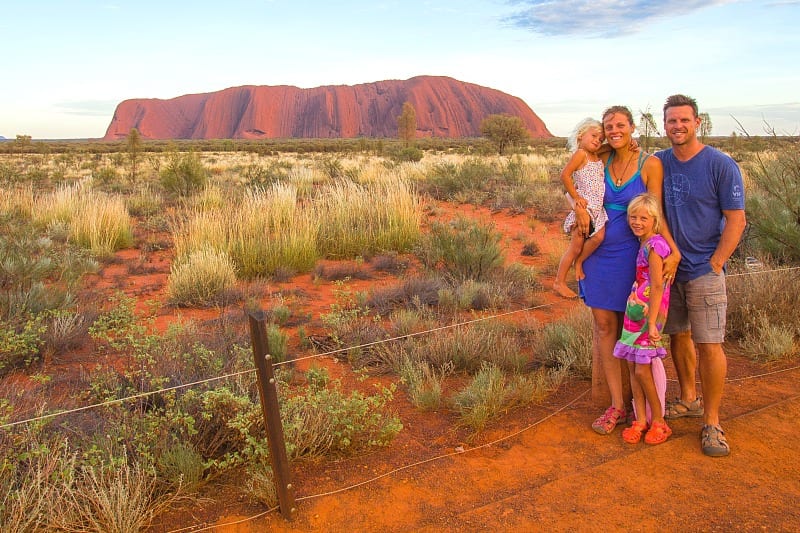
If you’re not sure where to go and what to see in Australia, then don’t worry. As Australians, we’ve explored a lot of our own backyard and have put together the ultimate 3 week Australia itinerary so you can see the best of our country.
- Is 3 weeks long enough in Australia?
- The Ultimate Three Week Australia Itinerary
- Days 1 – 3: Sydney, NSW
- Days 4 – 6: Cairns, Far North Queensland
- Days 7 – 9: Road Trip Cairns to Cape Tribulation
- Day 10: Fly to Alice Springs
- Days 11 – 15: Uluru & Red Centre Way
- Days 13 – 15: Uluru
- Day 16: Uluru to Alice Springs to Melbourne
- Days 16 – 18: The Great Ocean Road
- Days 19 – 21: Melbourne
- 21 Days and Beyond…
- Before You Go
- Tours of Australia
Is 3 weeks long enough in Australia?
But first, if you’re wondering if three weeks is long enough to see Australia, allow me to put your mind at ease. Three weeks is long enough to see much of the highlights of Australia.
It’s unlikely you will be able to fit in the whole country in three weeks (it’s massive), but you can see the best parts of Queensland and the East Coast, New South Wales, Victoria, and some parts of South Australia.
If this is your first time planning a trip down under, this guide will take you to the places in Australia I would suggest seeing and in an order that allows you to make the most of your time traveling in Australia.
If you follow this three week Australia itinerary, you’ll get to visit Australia’s two best cities, Sydney and Melbourne, the Great Barrier Reef, the Daintree Rainforest, Uluru, the Outback, see wildlife, and the Twelve Apostles on the Great Ocean Road.
If you have more time or plan to come back, then you can explore places like Western Australia and Tasmania on another trip. It’s just not possible to do it all in three weeks!
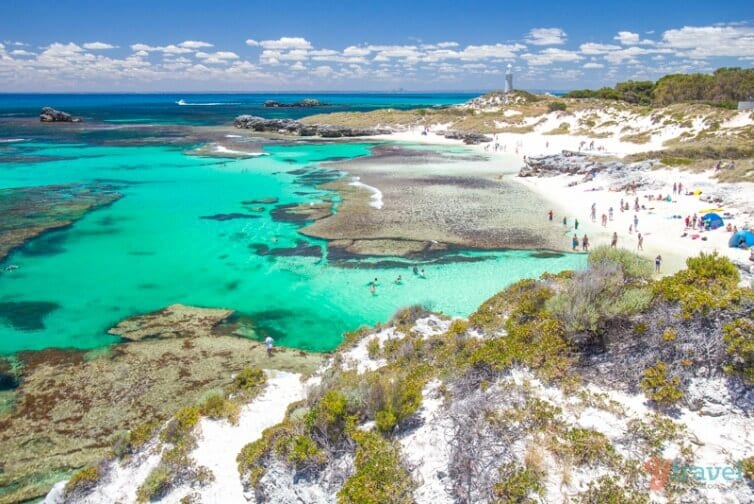
The Ultimate Three Week Australia Itinerary
The following itinerary is not set in stone, please use it as a guide and adjust it to suit your needs, time frame, and budget. Take what you like, and leave the rest.
For some parts of your trip you may need a rental car. We recommend Discover Cars as having the best booking platform for finding deals that is user friendly and backed by great customer service. I use them regularly for my car hire and love them. See rates and availability here.
If you are visiting multiple cities and attractions, then it may be a good idea to get an Australian Multi-City Flexible Attraction Pass. It can save you up to 40% off admission to Australia’s famous attractions, tours, cruises, and things to do all on one easy-to-use card.
Days 1 – 3: Sydney, NSW
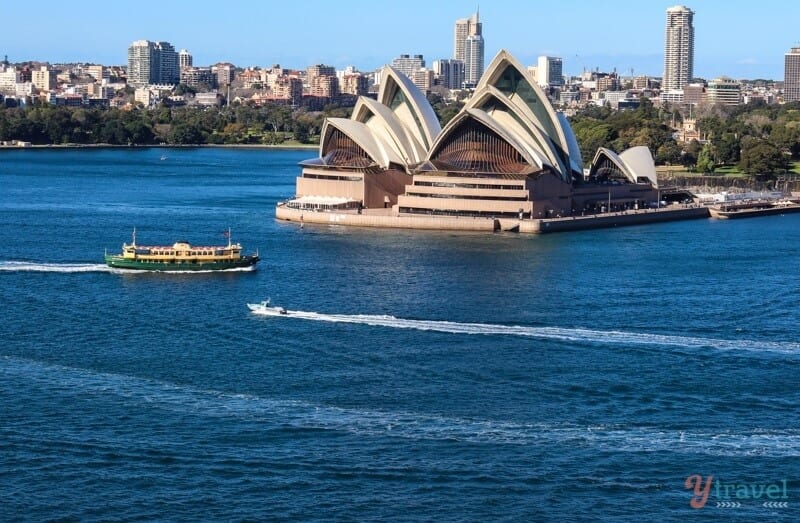
When you visit Australia you can’t miss Sydney. In fact, it’s most likely the first place you will fly into!
Besides being Australia’s largest city (but not the capital), there are many reasons why Sydney, NSW is also the most visited.
The stunning harbourside location, iconic beaches, excellent restaurants, fantastic cafes and pubs, world heritage sites, terrific shopping, incredible festivals, a multicultural population, and good year-round weather.
So don’t just use Sydney as a gateway to Australia, with so much to see and experience give yourself three days. Trust me, Sydney won’t let you down.
How to get into Sydney from the airport
The first thing you’re going to want to know is how to get from the airport to the city. To do this, simply hop on the Sydney Airport Link Train, which takes 15 minutes or so.
I recommend you get yourself an Opal Card, which is a smart card you can top up and use to pay fares on trains, buses, ferries, and the light rail. It will make traveling around Sydney much easier.
Alternatively, catch an Uber. The airport link is expensive, so sometimes an Uber works out to be about the same price and is more convenient as you can take it directly to the hotel. You can do a price estimate through the Uber app before you request it to double check
Once you’re in the city, I suggest you book your accommodation in the Sydney CBD so you’re centrally located to all the best attractions and make the most of your visit.
You’ll find several of Sydney’s highlights can be taken in for free or cheap simply by walking around this district.
Things to Do in Sydney
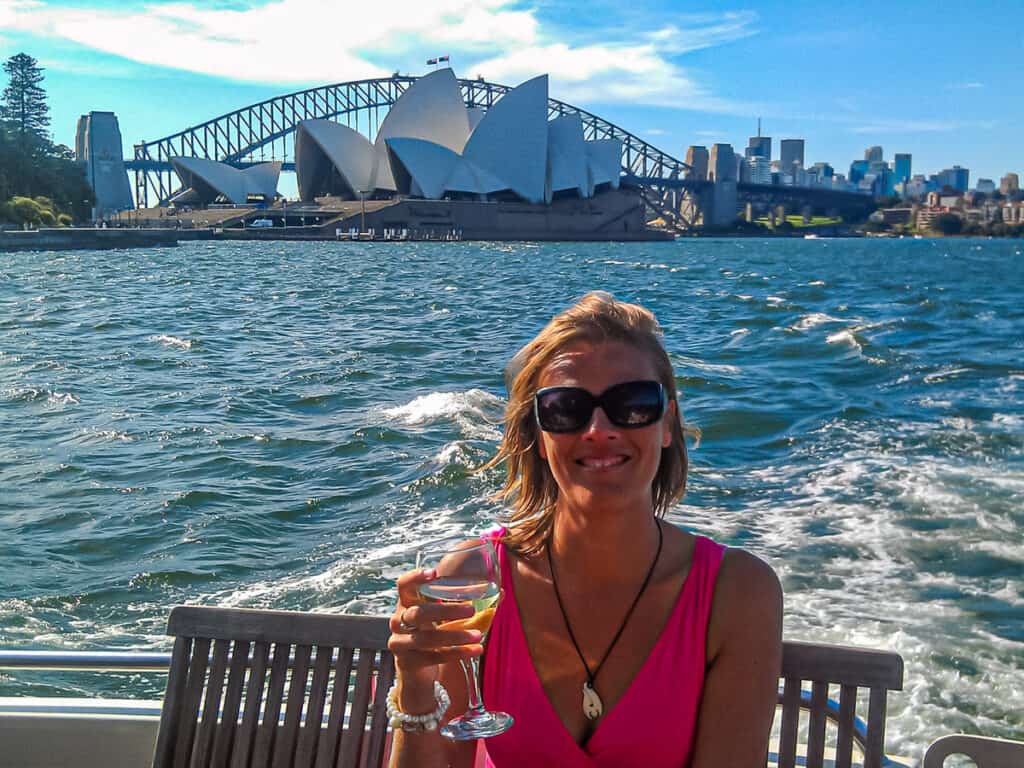
During your three days in Sydney, here are some of the attractions we recommend you visit. You may want to use your first day as an orientation day. Get yourself an esim card, walk around the CBD and check out the Sydney Opera House and Sydney Harbor Bridge.
For the other two days, here’s what we suggest you do.
- Walk Around Circular Quay – The best place to start your visit is in Circular Quay, the main transport hub of Sydney Harbour and where two of Australia’s most famous landmarks reside; Sydney Opera House and Sydney Harbour Bridge. Consider taking a 1 hour tour of the Opera House. Otherwise, just wander around and take your “I was here” photo.
- Royal Botanic Gardens – you can’t beat the serenity and harbour views from these gardens. Have a picnic or take a walk and admire the many different types of plants and city views on a free self-guided walking tour.
- Explore The Rocks District – The Rocks District is a historic area of Sydney and my favourite part of the CBD. It’s home to Sydney’s oldest pubs, cobblestone streets, weekend markets, and views of the harbour.
- Climb the Sydney Harbour Bridge – climbing one of the most famous bridges in the world is a once-in-a-lifetime experience. Take either dawn, day, twilight, or night climb and take in the breathtaking views. (Book well in advance).
- Walk across the Sydney Harbour Bridge – a cheaper option than climbing is to simply walk across for FREE and take in the same views on a lower level. Or visit the Pylon Lookout and get fantastic views plus 3 levels of exhibits to learn about the history of the Bridge.
- Bondi Beach to Coogee Coastal Walk – one of my favourite free things to do in Sydney. A stunning coastal walk and the perfect way to spend a gorgeous few hours in Sydney.
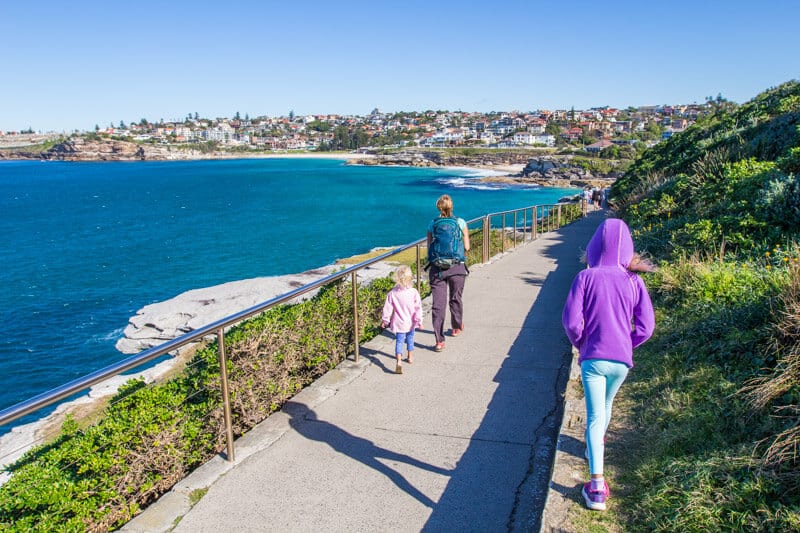
- Catch the ferry to Manly – a cheap way to experience beautiful Sydney Harbour with stunning views of the city is to catch the ferry from Circular Quay to Manly and back. In Manly, walk down the palm tree-lined Corso towards the beach for an ice-cream, walk around to picturesque Shelly Beach, or grab a cold beer at Manly Wharf Hotel. Time your return ferry trip back to the Quay to coincide with the sunset behind the harbour bridge.
- Surry Hills – walk around one of Sydney’s most artistically-vibrant neighbourhoods with old terrace homes, a great mix of cafes, restaurants, wine bars, and pubs. Wander Crown Street, Bourke Street, and Cleveland Street.
- Queen Victoria Building – Located on George street. The place to go for the finest fashion boutiques, jewellery, and homeware, plus cafes and restaurants.
- Darling Harbour – lively harbourside precinct just a 10-minute walk from the CBD and has cafes, bars, restaurants, a large kids playground and a program of fantastic free Sydney entertainment every week
- Walk through Hyde Park – Australia’s oldest park and the city’s central open green space. The park contains St Mary’s cathedral plus numerous monuments and statues, and the central pathway through the park is an impressive fig-lined road.
- Hit the beaches – Sydney is famous for its beaches, which are great free things to do in Sydney. From the Northern Beaches to the Eastern Suburbs you have many great beaches to explore. Our favourites: Bronte and Coogee in the eastern suburbs – and you must visit the famous Bondi Beach at least once. Manly, Freshwater, and Palm Beach are on the northern beaches.

- Taronga Zoo – A wide variety of Aussie and international animals with keeper talks and animal encounters makes for a great half-day as a family outing in Sydney. Catch the ferry from Circular Quay to Taronga Zoo which is situated in a natural bushland setting with spectacular views over the harbour. Get tickets in advance here.
- Sydney Tower – for $18 go up to the top of Sydney Tower, the city’s tallest free-standing structure standing at 309 m (1,014 ft) above the CBD. It has an observation deck with awesome views of the skyline. Get fast track entry tickets here.
- Art Gallery of NSW – free to enter and one of Australia’s leading art museums with collections of Australian, Aboriginal, European, Asian, and contemporary art.
- The Blue Mountains – take a day trip to the Blue Mountains and see the iconic Three Sisters rock formations.
Where to stay in Sydney
We mentioned earlier that the best place to stay in Sydney is the Central Business District, CDB. Here are some hotels we would recommend in this area:
Budget accommodation in Sydney:
- Sydney Harbour YHA – in the Rocks!
- Sydney Central YHA – close to Central Station
- Wake Up! – close to Central Station
Mid-Level accommodation in Sydney:
Luxury accommodation in Sydney:
Days 4 – 6: Cairns, Far North Queensland
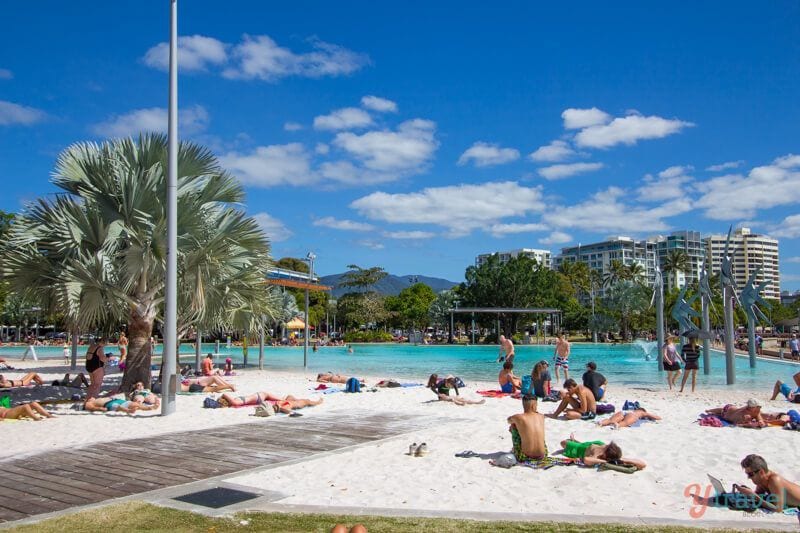
It might seem strange to board a plane immediately after arriving in Australia, but sadly to get everything packed into just three weeks, you’ll need to take a few internal flights. Far North Queensland is NOT to be missed
After you’ve caught a flight from Sydney to Cairns (3 hour’s flight) and checked into your accommodation in Cairns City, you’re ready to go exploring. Try to catch an early morning flight so you can explore in the afternoon and evening.
As one of Australia’s biggest tourist towns and the gateway to the Great Barrier Reef, Cairns is a vibrant city with plenty of things to do, and many great restaurants and cafes to keep you happy.
The weather is typically amazing, you can walk around at night in your shorts and flip-flops, and the days are filled with an enormous amount of choices of attractions to explore in the surrounding regions.
Whilst Cairns is mostly about getting out on the Great Barrier Reef, the surrounding hinterlands and nearby rainforests are definitely worth adding to your 3 week Australia itinerary.
Things to Do in Cairns
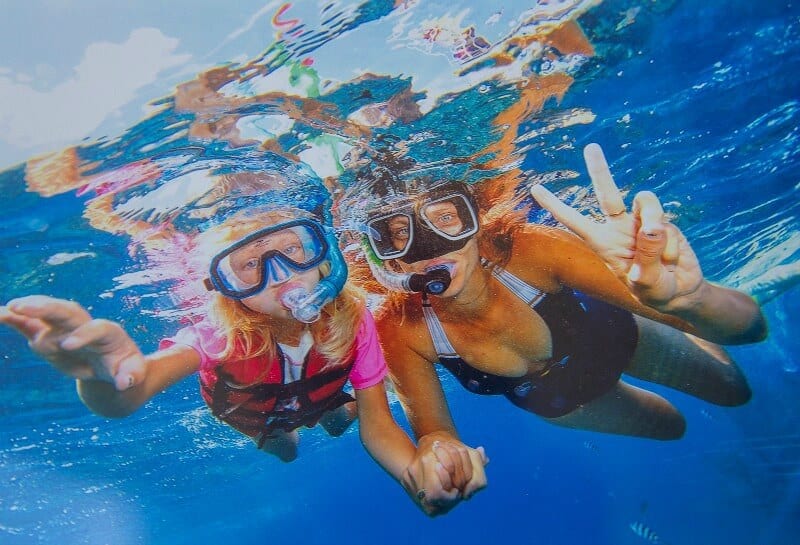
- Swim at the Cairns Lagoon – the cruelty of the north is you get hot summers but you can’t swim at the beaches, they’re full of stingers (jellyfish that can seriously harm you, even kill you). There are also a few crocs around too. The main beach in Cairns is also more of a mud flat. Not to fear, the man-made Cairns Lagoon gives you exactly what you need. Crystal clear waters, beach views, and lifeguards. It’s a cool place to laze around and read your book and it’s safe for swimming.
- Day trip to the Great Barrier Reef – a true wonder of the world that is 2,300km long and consists of 900 islands and 2,900 individual reefs. It’s the world’s largest coral reef and the largest living structure on the planet. There are many options for getting out on the reef, some of the main Barrier Reef Tour Operators are Reef Magic Cruises, Quicksilver Cruises, and Reef Experience.
- Green Island – a coral cay surrounded by white sandy beaches and magnificent coral reefs. You can snorkel straight off the shore and there’s a nice boardwalk through the forest to the other side of the island.
- Rusty’s Farmer’s Market – a bit of a Cairns institution and one of the cheapest farmers’ markets I’ve visited in Australia.
- Walk or cycle the Cairns Esplanade – take a stroll along the Esplanade in Cairns, watch the sunrise then grab breakfast at one of the busy cafes and restaurants that line the strip.
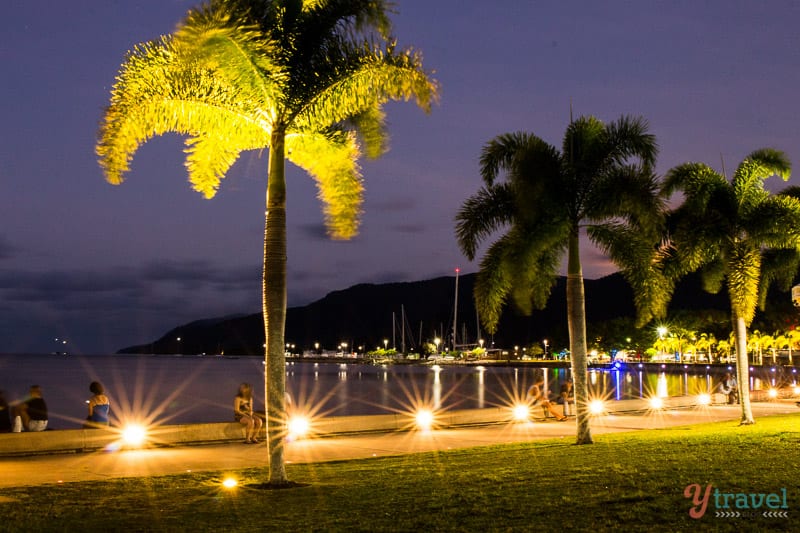
- The Cairns Night Markets – I wasn’t blown away by the Cairns night markets, but it’s a good way to pass an hour or so.
- White Water Rafting – down the Tully River, or the Barron River in Barron Gorge National Park with Raging Thunder Adventures. Check out tours here.
- Visit Kuranda – one of the most popular things to do in Cairns is riding the Skyrail Rainforest Cableway up to the hinterland town of Kuranda and then taking the Scenic Railway back down. Get tickets in advance here for both!
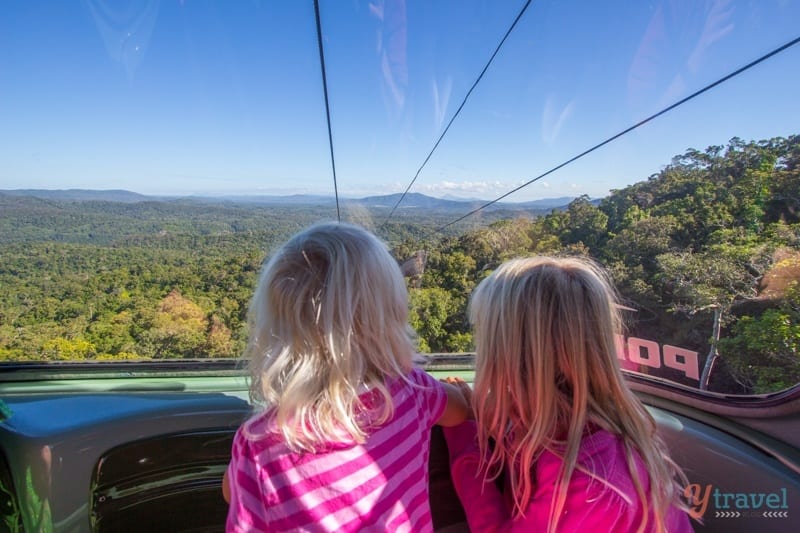
- Atherton Tablelands – about an hour southwest of Cairns, spend a day exploring this region, we especially loved the waterfall circuit.
Where to Stay in Cairns
We recommend you stay in the city center of Cairns so you’re close to all the action and attractions. Here are some great accommodation options to consider:
Budget accommodation in Cairns:
Mid-level accommodation in Cairns :
Luxury accommodation in Cairns –
For a full list of accommodation options in Cairns, take a look at what’s available via Booking.com.
Days 7 – 9: Road Trip Cairns to Cape Tribulation
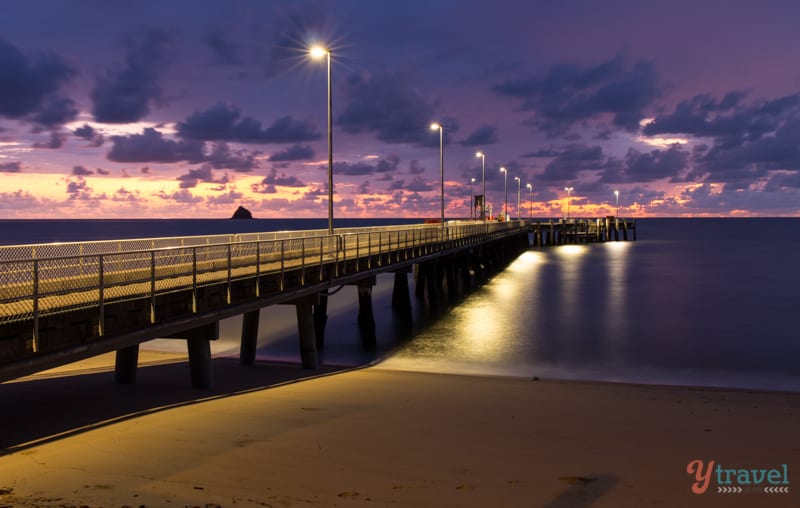
If you haven’t got one already, now is the time to pick up a rental car for your three-day loop drive from Cairns to Cape Tribulation via Port Douglas. This small road trip allows you to take in the best of the Tropical North Queensland area.
It’s one of the most enchanting regions in Australia.
I don’t suggest you do this drive as a day trip from Cairns though, it’s 140 km one way and will be too rushed, so either stay at Port Douglas and do a day trip from there (85 km one way) or stay within The Daintree and explore.
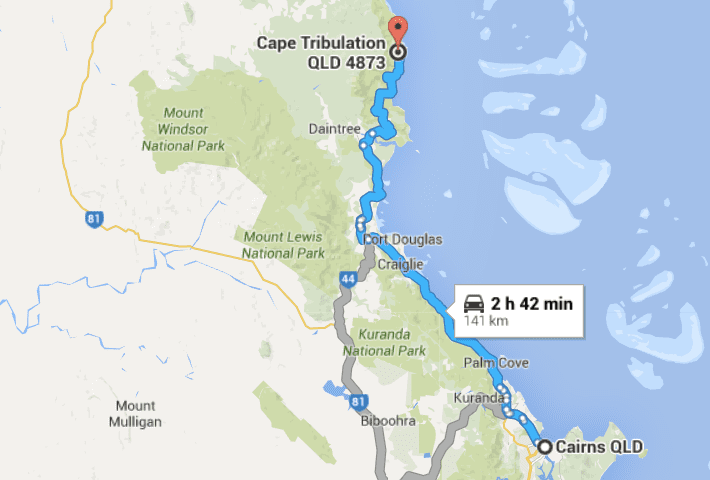
Day 7-8: Cairns to Port Douglas
This drive is one of Australia’s most scenic coastal roads, you’ve got the rainforest on one side and the Great Barrier Reef on the other.
If you were to drive from Cairns to Port Douglas without stopping it would only take you one hour, but consider stopping at Palm Cove along the way.
Palm Cove is a colourful village and is considered to have one of Australia’s most idyllic beaches (there’s a designated swimming area during the stinger season).

There’s a beachfront playground for children and a gorgeous esplanade to stroll back and forth along for coffee, gelato, or endless restaurants to dine in.
If you don’t head straight to the Daintree, Port Douglas is a fantastic place to base yourself and explore more of the tropical north. And it’s also another good base to head out on to the Great Barrier Reef. We recommend spending two days exploring this stretch of coastline.
Things to See and Do in Port Douglas
- Check out 4 Mile Beach – swim, walk or laze under a palm tree.
- Spend a day on the Barrier Reef – Check out Quicksilver, Wavelength, or Calypso. Barrier reef tours from Port Douglas can be found here.
- Sailaway Reef and Island Tours – take a sunset cruise, afternoon cruise, or full-day cruise. See more sailing tours here.
- Mossman Gorge – the southernmost end of the Daintree Rainforest. It’s ancient and pristine. A boardwalk takes you to the Mossman River and a beautiful swimming area.

- Lady Douglas River Cruise – cruise down Dickson Inlet on an iconic riverboat.
- Flames of the Forest – dine in the rainforest and have an aboriginal cultural experience.
- Hartleys Crocodile Adventures – one of the best places to see crocodiles and local wildlife.
- Sunday Markets – a local’s favorite.
Where to Eat & Drink in Port Douglas
- Surf Club Bar and Bistro – local’s favourite for lunch, dinner, coffee, and drinks.
- Yacht Club – Fantastic location and seafood. Great value meals and well-priced drinks.
- Courthouse Hotel – It’s an absolute must for beer and fresh prawns.
- The Tin Shed – Watch the boats come in the late afternoon and enjoy the cheapest drinks in town.
- Salsa Bar – Excellent ambiance and food. Fantastic cocktails and margarita jugs!
Where to Stay in Port Douglas
Port Douglas is a small town and a great base for exploring the tropical region of Cairns. Here are some great places to stay in the area:
Budget accommodation in Port Douglas:
Mid-level accommodation in Port Douglas:
Luxury accommodation in Port Douglas:
For a full list of accommodation options in Port Douglas, check out more options on Booking.com
Day 9: The Daintree Rainforest and Cape Tribulation
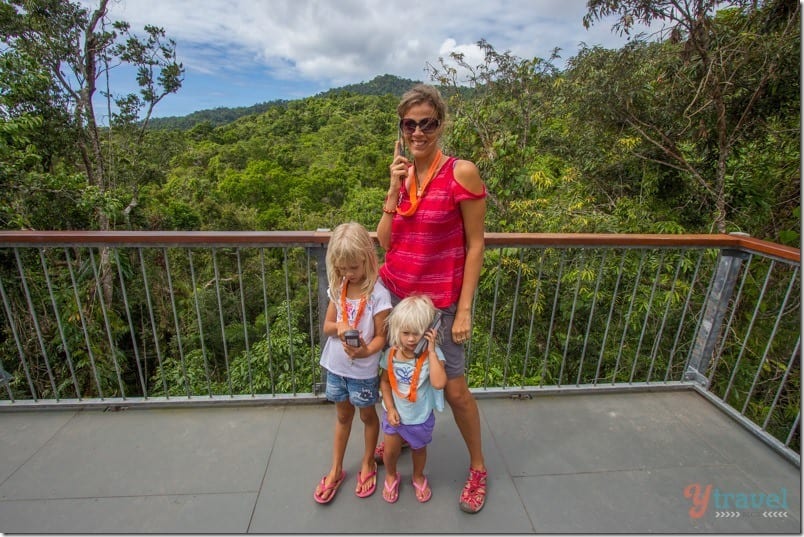
At 110 million years old, the Daintree Rainforest is possibly the oldest existing rainforest in the world, even pre-dating the Amazon.
It’s World Heritage listed and sits smack bang alongside the Great Barrier Reef – the only place in the world where two World Heritage sites meet. It’s a must-visit part of Australia!
From Port Douglas, the furthest north we have been to is the spectacular Cape Tribulation (85 km one way).
Cape Trib is a headland located within the Daintree National Park.
Things to Do in the Daintree Rainforest
- Cape Kimberley – the first beach you come to in Daintree National Park.
- Alexandra Lookout – stop here for beautiful views out over the Alexandra Range and Snapper Island.
- Daintree Discovery Centre – do the self-guided audio tour and aerial walkway.
- Cow Bay
- Maardja Botanical Walk – the 540m boardwalk follows the creek through a section of rainforest and past the eerily twisting roots and vines of the mangroves to a lookout over Noah Creek.
- Cape Tribulation – the prettiest of the beaches in the Daintree. Walk along the beach and then back up to the Kulki boardwalk.

- Dubuji Boardwalk – the 1.2km boardwalk winds its way through the mangroves, shaded by it’s canopy of enormous fan palms, strangler figs and vines leading down to Myall Beach.
- Myall Beach
- Kayaking at Cape Tribulation.
Where to Eat & Drink in the Daintree
- Mason’s Cafe – the burgers are legendary. Pick your animal: wild boar, emu, crocodile or kangaroo.
- Daintree Ice Cream Company – for $6 get a bowl of ice cream with four scoops. The flavours depend on what they’ve made at that time based upon the exotic fruits that have been harvested from the orchard.
- Thornton Beach Cafe – nice spot to stop for lunch or breakfast right on Thornton Beach.
Where to Stay in the Daintree Rainforest
There are not a huge amount of places to stay in the Daintree, but here are some great options:
Budget accommodation in The Daintree:
Mid-level accommodation in The Daintree:
Day 10: Fly to Alice Springs
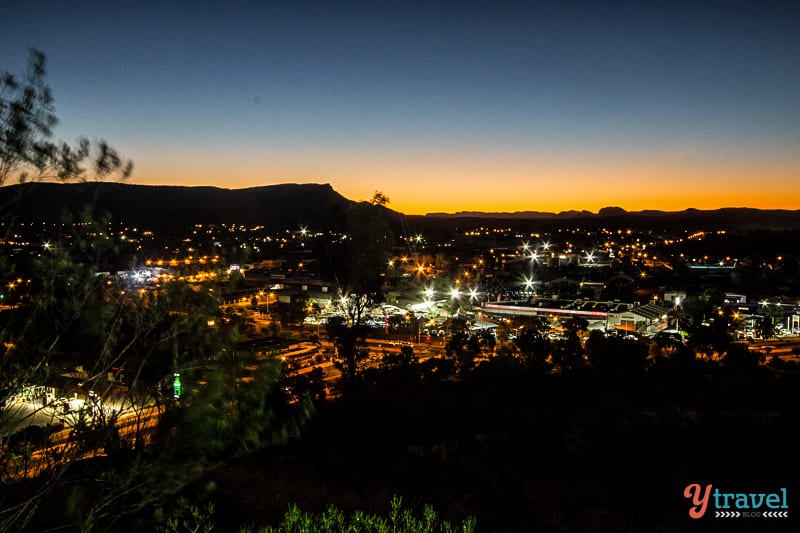
After you return your rental car to Cairns airport, you’ll want to fly to Alice Springs in the Northern Territory and visit Australia’s most famous Outback town and start your Outback adventure. The flight, even direct, takes 6 hours and 10 minutes. That’s how big Australia is!
Sadly, you will need to use day 10 as a full travel day, but it will be totally worth it to see this desert town and its surrounding attractions.
Alice Springs is the thriving, spirited outback centre and is famous for the personality of its locals and contemporary and traditional art, and of course the natural wonders.
Framed by the MacDonnell Ranges and the desert landscape, Alice has all the conveniences of a modern township imbued with a rich living Aboriginal tradition and European explorer history.
You could spend a day or a week exploring the sites of Alice Springs. If you’re lucky to catch an early flight, you might have time to explore in the afternoon or evening if you’re not too tired.
Whatever you do after you land, make sure you get a 4-wheel-drive rental car in Alice Springs for the next five days of exploring Central Australia.
Things to Do in Alice Springs

- Telegraph Station Historical Reserve – learn about the construction of the Overland Telegraph Line from Port Augusta in South Australia to Darwin. Onsite cafe and walking and cycling tracks.
- School of the Air visitors centre – learn about the world’s largest classroom, covering more than 1.3 million square kilometres.
- The Kangaroo Sanctuary – Get up close with kangaroos at the home of Brolga, star of the documentary series Kangaroo Dundee – BBC UK / Nat Geo USA. Do the guided sunset tour!
- Royal Flying Doctors Service Museum – learn about one of the largest aeromedical organisations in the world, providing extensive primary health care and 24-hour emergency service to people over an area of 7.3 million square kilometres.
- Desert Park – see the animals that live in Central Australia’s habitats.
- Anzac Hill – for a panoramic view of the town. Sunrise is the perfect time as you watch the sun slowly rise to light up the MacDonnell Ranges and the beautiful desert town below.
Worried about all the deadly animals in Australia? Don’t be. This guide will help ease your fears. I hope!
Where to Stay in Alice Springs
Alice Springs is a lively town with lots of great accommodation options. The good news is you can walk from everywhere in the town, so you don’t have to worry too much about the neighborhood you stay in. Here are some great accommodation options for Alice Springs:
Budget accommodation in Alice Springs:
Mid-level accommodation in Alice Springs:
High-end accommodation in Alice Springs:
Days 11 – 15: Uluru & Red Centre Way

The Red Centre Way is one of the Australian Outback’s great drives, stretching from Alice Springs to Uluru and taking in the stunning landscapes of Kings Canyon and Ormiston Gorge.
There is so much to see and do along the drive, you simply need a few days to complete it. At the bare minimum, we recommend three days.
Day 11: Alice Springs to Glen Helen Homestead

Today’s drive is approximately 177 km’s from Alice Springs to Glen Helen Homestead taking in some of the best scenery in Central Australia along the West MacDonnell Ranges.
Things to Do in the West MacDonnell Ranges

- Simpsons Gap (23km from Alice Springs via Larapinta Drive) – a prominent waterhole is an important spiritual site to the Arrarnta Aboriginal people. At dawn or dusk, Simpsons Gap is renowned as a place to see Black-footed Rock-wallabies along the gap’s short walking track.
- Standley Chasm (40km) – When the sun’s light shifts across the cleft, the walls of Standley Chasm glow golden, orange, and red. There’s a pretty 15- 20 min walk along the creek beside rare ancient cycads, where spring-fed pools give the valley floor a lush, tropical oasis feel. Onsite cafe.
- Ellery Creek Big Hole (57km) – a favourite swimming hole for the locals and a great spot for a picnic.
- Ochre Pits (22km from Ellery Creek) – brightly coloured small cliffs that local Arrarnta Aboriginal people have used for thousands of years for their ceremonial paint. The layers of white, yellow, and red ochre of the cliffs are so rich and earthy.
- Ormiston Gorge (24km) – the biggest and prettiest swimming hole. It’s also the most popular. There is a kiosk open here that apparently serves a phenomenal iced coffee.
- Glen Helen Gorge (11km) – The permanent waterhole at Glen Helen Gorge is a favourite home to many species of desert wildlife and lies at the headwaters of the Finke River, where you can walk along the riverbed between the gorge walls to see fabulous cycads. The traditional owners believe Glen Helen Gorge is the home of an ancient and powerful Rainbow Serpent.
Stay overnight at Glen Helen Homestead Lodge which offers motel room type accommodation for families or singles plus caravan and camping sites. There’s a restaurant, bar, fuel (diesel & unleaded), and a swimming pool.
Day 12: Kings Canyon
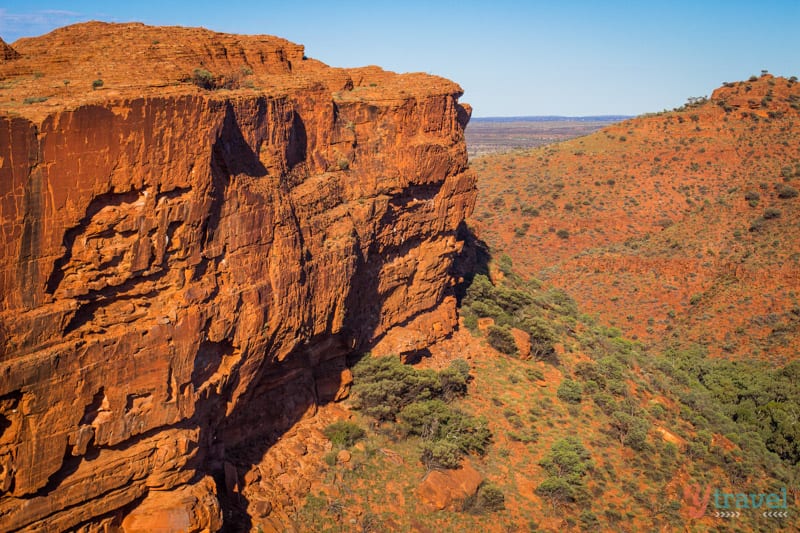
Enjoy breakfast out on the deck at Glen Helen Homestead. The views out over the West Mac ranges are stunning and it is very serene watching the eagles soar quietly above looking for their own breaky.
Depart Glen Helen and drive 225km along the Mareenie Valley Road, stopping overnight at Kings Canyon Resort.
Make sure you have a full tank of fuel, water, and food supplies. This section of road is unsealed and can be badly corrugated, that’s why we suggest a 4×4 vehicle for clearance and comfort and control not because it’s technical off-road driving.
Some people drive this in a 2WD but a 4WD would be better.
Kings Canyon Resort offers comfortable lodging and hotel-style rooms plus camping and caravan sites. Facilities include 2 restaurants, 2 swimming pools, and a petrol station.
Hiking Kings Canyon
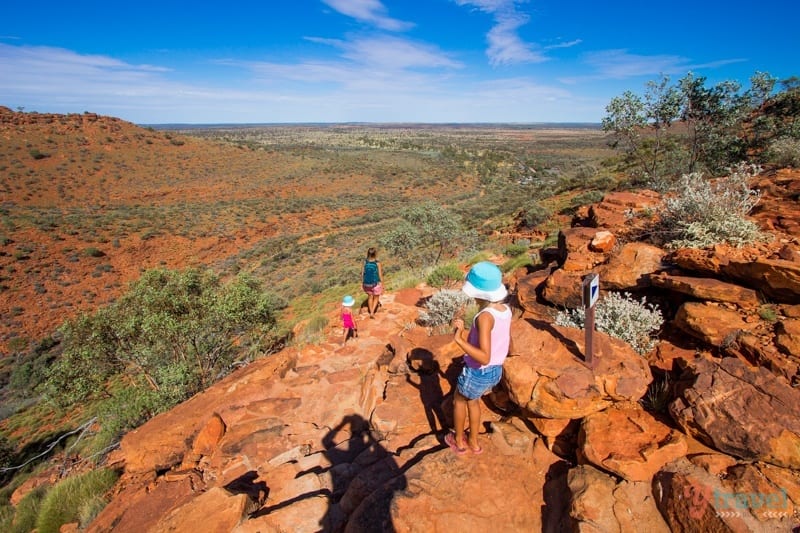
Iconic Kings Canyon is just 7 km from the resort.
The 5.5km Kings Canyon Rim Walk in Watarrka National Park offers spectacular views of the canyon and stunning dome-shaped rock formations and the colours change as the sun continued its journey up.
We did it at sunrise with our three and six-year-old daughters, with the only steep part of the walk being the climb to the top at the beginning.
Kings Canyon to Uluru (Town of Yulara)
The drive from Kings Canyon to Yulara, the main town at the gates into Uluru-Kata Tjuta National Park where all the accommodation and shops are, is 300km.
If you don’t want to visit on your own, check out this full-day tour of Kings Canyon from Uluru.
Days 13 – 15: Uluru
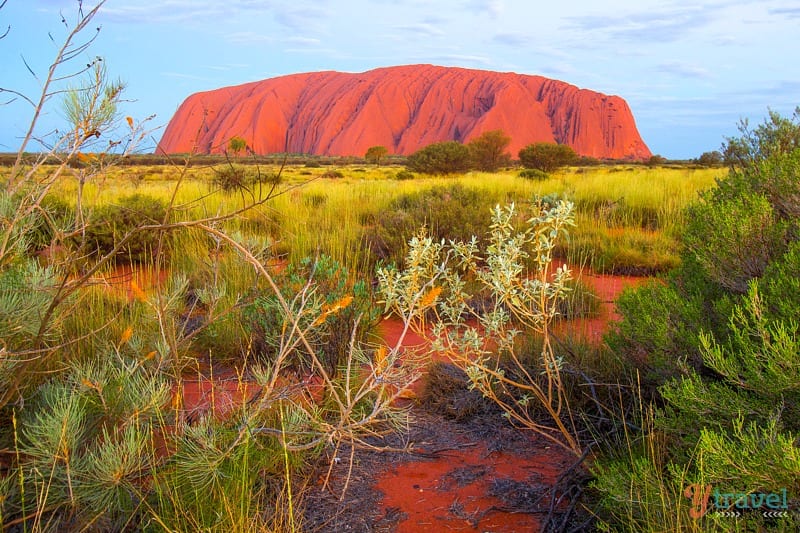
Uluru, previously known as Ayers Rock, is the spiritual heart of the country and a must-see when you visit Australia.
You’ve probably seen hundreds of photos and TV commercials of Uluru, but it’s a place you have to see and feel, for yourself.
Made of arkosic sandstone, Uluru stands 348 metres high and is taller than The Eiffel Tower and 2.5 times the height of Sydney Harbour Bridge.
We highly recommend you don’t fly in and out in a hurry, Uluru needs more than one night to appreciate its beauty!
Things to Do at Uluru
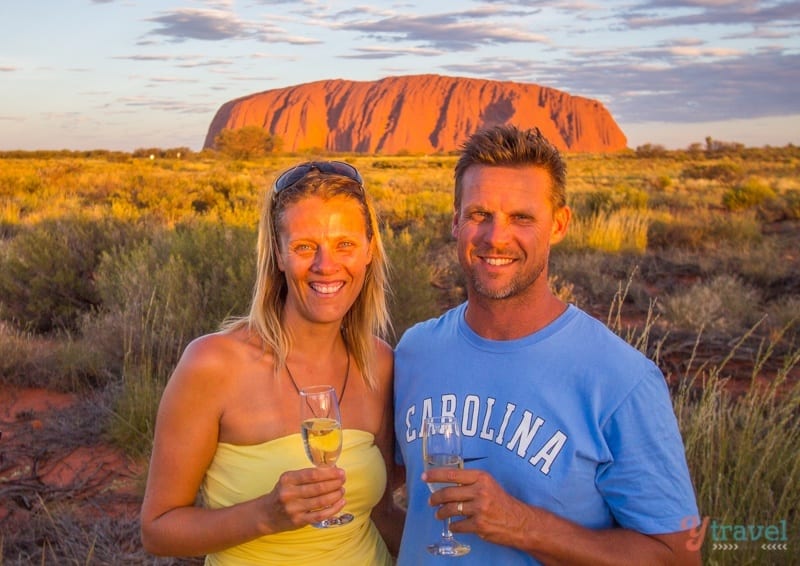
Many people visit Uluru just for Ayres Rock, but there are actually a lot of things to do near Uluru and worth checking out. Here are some of our favourite activites nearby:
- Uluru Sunset – the are several lookout spots for sunset and every lookout offers a different perspective of the vibrant and ever-changing colours. The most popular sunset spot is the official Uluru Sunset Lookout about 10 kilometres down the road through the entrance gates of the park (entry fee $25 for three days).
- Uluru Sunrise – we dragged the kids out of bed at 5.00 am each day and jumped in the car for the 20-minute drive from Yulara into the park (sunrise was around 6.20am). For our first Uluru sunrise, we headed back to the Talinguru Nyakunytjaku lookout. Be warned, this is where hordes of people and tour buses converge and was very busy even in the off-season.
HOT TIP – for a great Uluru sunrise silhouette, on another morning we headed back to the sunset lookout spot as you get the rock blocking the sun as she rises. Whilst everyone heads to the Talinguru Nyakunytjaku lookout for sunrise, we had this sunset spot all to ourselves!
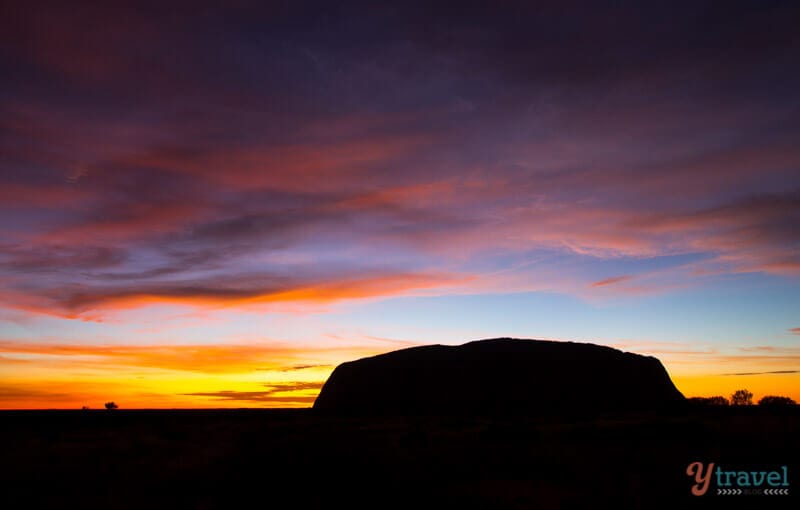
- Base walk – The loop walk is 10 km around the base and it took us 3.45 hours with a three and seven-year-old and taking lots of photos. The walk is completely flat, just remember you’re in the Outback so it’s best to start early at first light to beat the heat. The park opens daily at 5am and we suggest starting at the Kuniya walking point and heading anti-clockwise. Take lots of water, snacks, and short breaks
- Cycle the base – if you’re not up to walking the 10.6 kilometres around the base, a great alternative is to hire bikes from Outback Cycling or bring your own and bike it. We had a tag-along for Kalyra who enjoyed the relaxation of letting daddy do most of the peddling, and little Savannah took in the sights in a baby seat on the back of Caz’s bike.

- Free Ranger Guided Mala Walk – your third option, if you don’t want to walk or bike the whole 10.6 kilometres of Uluru, is to participate in the two-kilometre return walk (1.5 hours) free ranger-guided Mala walk.
- Sunset drinks – A fitting farewell to our time at Uluru was sipping on a few glasses of champagne with the folks from AAT Kings as the sunset over the rock. Check out sunset viewing and bubbly experiences here.
- Sunset Camel Ride – one of the unique ways to take in Uluru is on the back of a trusty camel. Our kids, and us big kids, absolutely loved this experience with Uluru Camel Tours.
- Sounds of Silence – On our bucket list is the Sounds of Silence dining experience under the stars (when the kids are a bit older) and a helicopter flight sounds amazing too!

Things to Do in Kata Tjuta
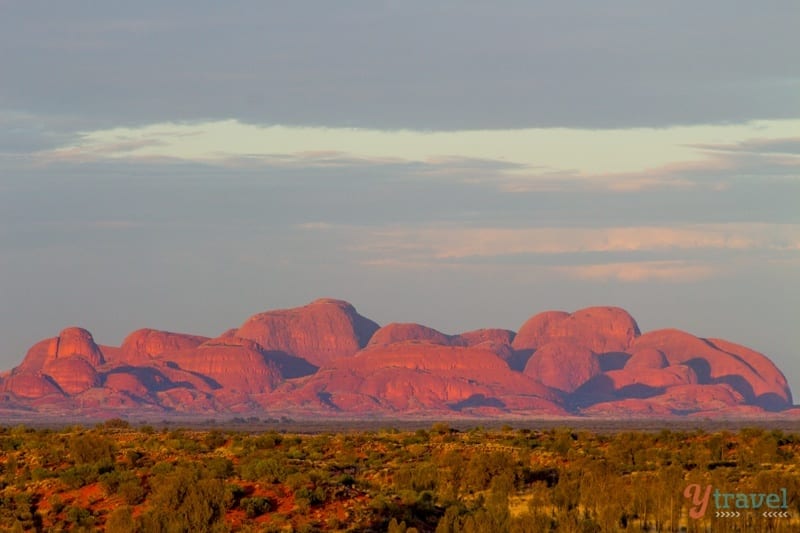
Kata Tjuta is just 50km’s up the road from Yulara and is equally as impressive as Uluru.
Formerly known as The Olgas, this group of large ancient rock formations consisting of 36 ochre-coloured domes are spread over an area of more than 20 kilometres.
The sandstone domes are believed to be around 500 million years old.
Walks at Kata Tjuta:
- The 2.6 km Walpa Gorge walk is the shorter and easier of the two walks.
- The longest trail is the 7km Valley of the Winds Walk.
Hot tip – for another brilliant sunrise silhouette of Uluru head to the Kata Tjuta dune viewing area.
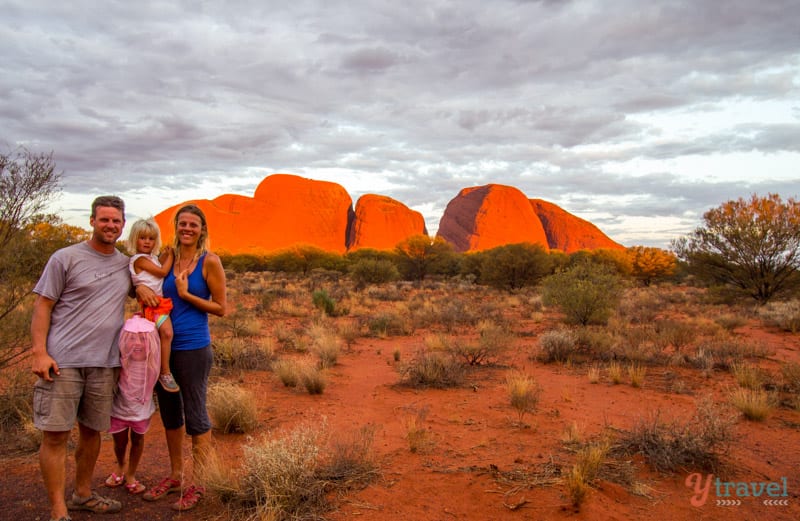
Where to Stay at Yulara
There is not a huge range of options at Yulura, but here are some great places to stay:
Budget accommodation at Yulara, Uluru:
Mid-range accommodation at Yulara, Uluru:
Luxury accommodation at Yulara, Uluru:
Day 16: Uluru to Alice Springs to Melbourne

The drive from Yulara back to Alice Springs is 447km via the Lasseter Hwy and National Hwy 87.
Alternatively, instead of driving back to Alice Springs and catching a flight to Melbourne, you could do a one-way drop off of your rental car at Ayers Rock Airport, which you can do through RentalCars.com and fly to Melbourne from there.
You just need to weigh up the cost of a one-way rental drop off versus the different flight prices to Melbourne from either Alice Springs or Ayers Rock! To save yourself time as you only have three weeks in Australia, it’s worth dropping it off at Ayres Rock and flying from there.
Jetstar, Qantas and Virgin Australia fly direct to Melbourne from Ayers Rock Airport.
In fact, if you want to shorten this whole 3 week itinerary of Australia and skip Alice Springs and the Red Centre Way, you can fly direct from Cairns to Ayers Rock Airport, then onto Melbourne.
Just an option to add extra days at the other locations.
Days 16 – 18: The Great Ocean Road
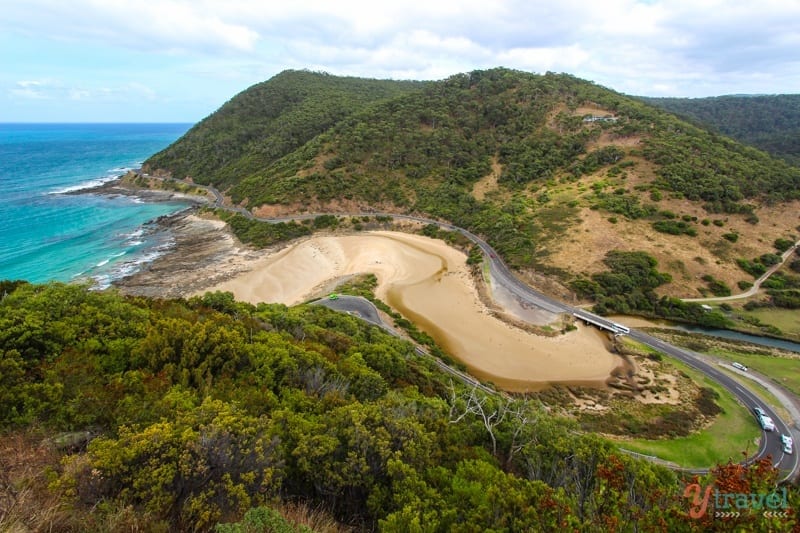
Pick up your rental car from the airport in Melbourne and hit the Great Ocean Road, famous in Australia and around the world as one of the best drives on the planet.
The start of the drive is only one hour outside of Melbourne in the town of Torquay, it stretches over 250 kilometres to Warrnambool, and attracts tens of thousands of visitors every year.
Many people even take the Great Ocean Road all the way to Adelaide.
Whilst the tour buses crazily drive this in one day, you really need at least two or three days to see all the sites. Don’t just rush to the 12 Apostles for your tourist snap. Slow down and appreciate all it has to offer.
Visit all the rock formations and towns, walk on a beach and visit the rainforest, see a waterfall and wildlife, sit at a lookout, and be present.
I recommend overnighting in Lorne, Apollo Bay and Port Campbell along the way.
Hot Tip – drive from Torquay to Warrnambool (East to West). That way you’ll be on the left side of the road closest to the ocean and you’ll be able to pull over easier to all the viewpoints.
Things to Do on the Great Ocean Road
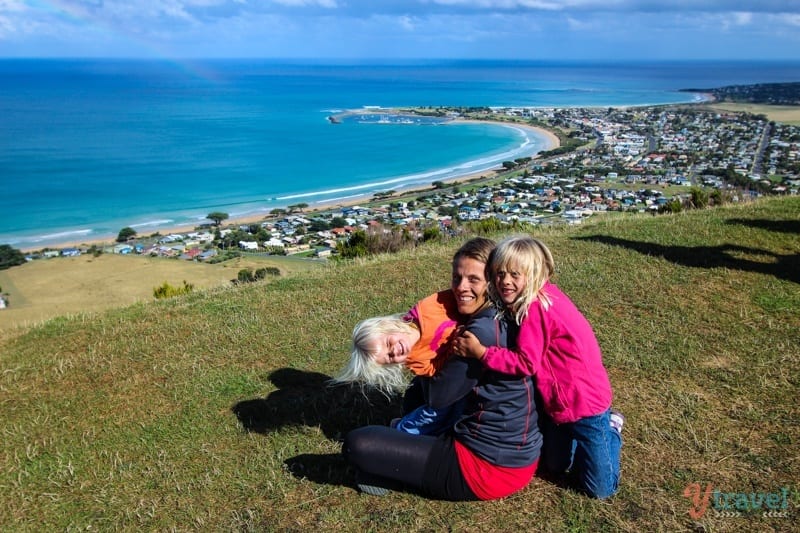
- Torquay (104 km’s from Melbourne) – Bells Beach is one of Australia’s most famous surfing beaches. Visit the Australian National Surfing Museum. Do a section of the Surf Coast Walk.
- Anglesea (18 km) – get some sun on Anglesea’s main beach, a wide sandy expanse beside the Anglesea River. Walk along the rugged coastline or head inland beside the Anglesea River on the 44-kilometre Surf Coast Walk.
- Aireys Inlet (9 km) – Split Point Lighthouse was built in 1891 and is perched on the cliffs, 70 metres above sea level. Walk along surrounding clifftop tracks to see rocky reefs, rock pools, and sheltered coves (keep your eye out for whales in season).
- Lorne (20 km) – a picturesque town situated right on the Great Ocean Road. Great cafes, unique shops boutiques, galleries and Otway National Park are on your doorstep. Enjoy a walk on the beach, a bike ride along the foreshore out to the pier, have a coffee at Lorne Beach Pavilion and try a burger from The Bottle of Milk. Teddys Lookout is a short drive up the hill behind Lorne. Drive up to the picnic area at the end of George Street and walk a short distance to enjoy the spectacular views of the Great Ocean Road from the lookout.
- Lorne to Apollo Bay Drive – our favourite stretch of road along the GOR. Be prepared to stop for photos a lot. This stretch of road has some of the most picturesque scenery in the region. It hugs the cliff-face as it winds through the Great Otway National Park and rolling farmland.
- Apollo Bay (47 km from Lorne) – seaside village halfway along the Great Ocean Road and surrounded by Otway National Park State Forest. Mariners Lookout offers panoramic views of Apollo Bay’s town centre, the harbour, and beaches up and down the coast, located at the northern end of town off Marriners Lookout Road. Climb aboard a kayak, get up close to local seal colonies or sign up for a deep sea fishing adventure. There are sunset beach rides on horseback, gift shops, galleries and tea houses along with countless culinary delights on offer – fishing is an important local industry so seafood is always on the menu!
- Otways National Park – head into the Otways and immerse yourself among tall trees and giant tree ferns, and beautiful waterfalls – Triplet Falls is a highlight. The walk is about a 1 hour return loop. And the 2km Shelley Beach Circuit Walk is one of the best short walks on the Great Ocean Walk.
- Kennett River – want to see koalas in the wild? The best koala viewing spot is Kennet River, along the Grey River Road, just in the middle of town. Otway Lighthouse Road is another popular spot. Just look for the crowds of people and follow their gazes up for quick koala spotting.
- Twelve Apostles (87 km from Apollo Bay) – Port Campbell National Park is home to these massive limestone structures tower 45 metres above the ocean and were formed some 20 million years ago. There are only eight remaining (the rest have fallen) and forming the backdrop are these magnificent cliffs up to 70 metres high. Hot Tip – get there for sunrise or sunset so you miss the hordes of people and tour buses that arrive around lunchtime (we stayed overnight in Port Campbell, 15 km drive, and drove back for sunset).

- Gibson Steps – just down the road from the Twelve Apostles Visitors Centre are the Gibson Steps. Walk down these steps onto the beach for a close-up view.
- Loch Ard Gorge – a few minutes drive west of The Twelve Apostles. Named after the ship Loch Ard, which ran aground on nearby Muttonbird Island at the end of a three-month journey from England to Melbourne.

- The Grotto – is basically a sinkhole. Take the steps down the cliff face to the bottom and look through and you’ll get visibility of the ocean beyond a pool at low tide. Pretty cool.
- London Arch (London Bridge) – formed by a gradual process of erosion and originally was a complete double-span and attached to the mainland. The arch closer to the shoreline collapsed unexpectedly in 1990.
- The Arch – this naturally sculptured arch stands 8 metres high and is located 6km west of Port Campbell.
- Bay of Islands – head a little further south to Peterborough and you’ll discover the mystical Bay of Islands and Bay of Martyrs. Almost as beautiful as 12 Apostles, yet rarely talked about.
The direct drive back to Melbourne from Warrnambool is 255 km (approximately 3 hrs) via the Hamilton Hwy/B140 and M1. Drop off your rental car at the airport in Melbourne and make your way into the city.
Melbourne Airport is located 25 km from the City Centre. The Sky Bus offers a regular shuttle service 24/7 direct to Southern Cross Station in the city so you won’t need your rental car anymore.
They also offer a hotel drop off and pick up service – ask for details at the counter.
Days 19 – 21: Melbourne
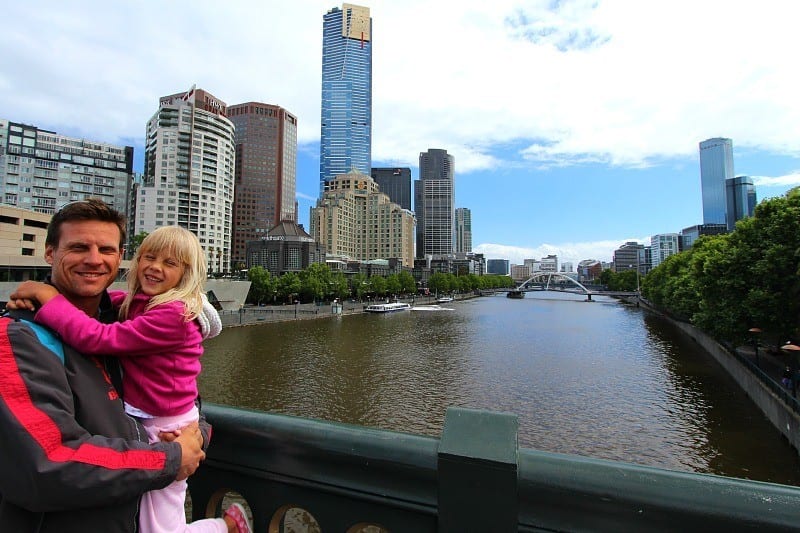
We love Melbourne, it’s probably our favourite Australian city and feels very European.
The downside is it comes with four-seasons-in-one-day weather patterns. Wear layers!
There really is something for everyone in Melbourne, no matter what your budget or tastes are. Also, it is a well-known fact among Australians that they make the best coffee in the country!
Things to Do in Melbourne
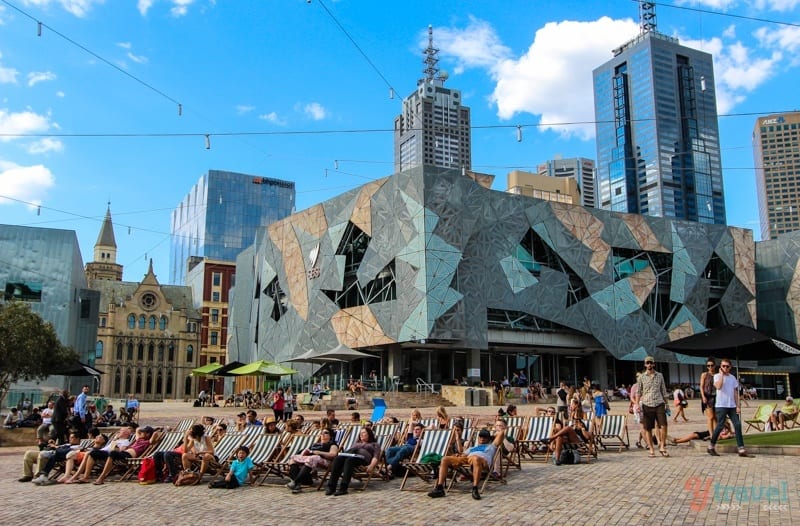
- City Circle Tram – jump on the FREE city circle tram service (route 35) that operates within Melbourne’s CBD and passes major tourist attractions. The loop takes about 45 minutes and you can get off at any one of the many stops to explore more on foot, and is the best way to get around to many of Melbourne’s inner city highlights.
- Federation Square – Fed Square occupies a whole urban block right on the banks of the Yarra River and directly opposite Flinders Street Train Station and St Paul’s Cathedral in the heart of the city. There’s museums, galleries, restaurants, bars, festivals, and fun. And the Melbourne Visitor Centre is located underground. Such a cool urban square!
- Shopping – the city laneways, especially between Flinders, Elizabeth, Bourke, and Swanston Streets are terrific. Little Collins Street is also very good for relieving you of some of your cash. Also check out Prahran and Chapel Street which runs from the Yarra River in the north to Brighton Road in the south, traversing the suburbs of South Yarra, Prahran, Windsor, St Kilda, and St Kilda East.
- St Kilda – jump on a tram and head to this seaside escape. It’s the closest and easiest beach to get to from the city, just 6km away, and it’s Melbourne’s most famous beach. There’s outdoor dining and bars, many with bay views, and the sunsets are pretty special. Acland Street is the place to go for cafes and restaurants, but also for the famous cake shops. West Beach Cafe is right on the sand and Jerry’s Milkbar is a converted milkbar with a little playground out the back and awesome banana bread. Check out Carlisle St in St Kilda East, an easy walk from Acland St. Less touristy, and a bit grimey, but lots of character and great cafes.
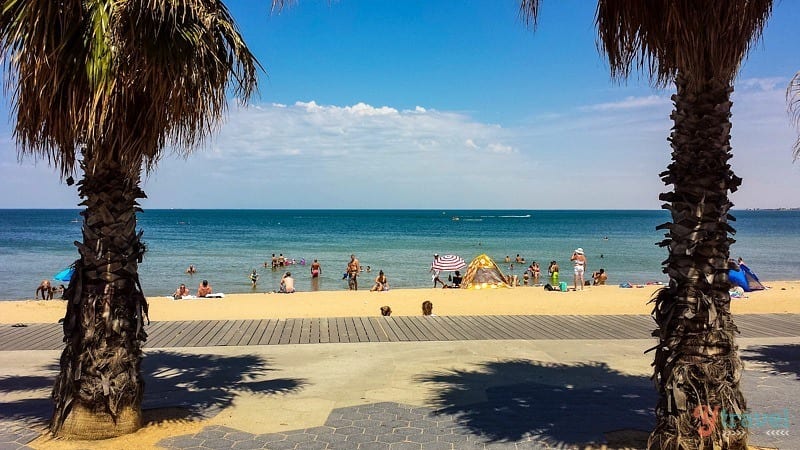
- See penguins at St Kilda Pier at dusk – why go to Phillip Island for the penguin parade when there is a free one right in the city? The fairy penguins come in and bring smiles to everyone who sees them.
- Queen Victoria Market – who doesn’t love a good open-air market? The Queen Vic Markets has something for everyone. Grab some fresh produce and head to either Fitzroy Gardens or Carlton Gardens for a picnic.
- Wednesday Night Markets (summer months only) – Queen Vic Markets come alive with great street food, with offerings from all over the world. It was like any night food market you’d find in Asia, buzzing with atmosphere and cheap (for Melbourne) street food. Live music and family-friendly.
- AFL game – if you’re here during the AFL (Australian Football League) season, you must check out a game. The atmosphere in the massive MCG (Melbourne Cricket Ground) is unlike anything else in this country.
- Fitzroy – for the cafes and restaurants, not to mention all of the boutique shops, many catering to a hip crowd.
- Lygon Street – for all things Italian. We recommend Tiamo for great and affordable Italian. And Brunetti’s is a Melbourne institution for coffee, cakes, and pastries.
- Laneways – Melbourne is famous for its laneways. Centre Place is a busy laneway between Flinders Lane and Collins Street and home to several vibrant bars, cafes, restaurants, boutiques, sushi bars, and shops, as well as some of Melbourne’s best examples of street art and graffiti. As is Degraves Street. Hardware Lane has lots of great Italian. Royal Arcade is old and very beautiful (great chocolate shop too).
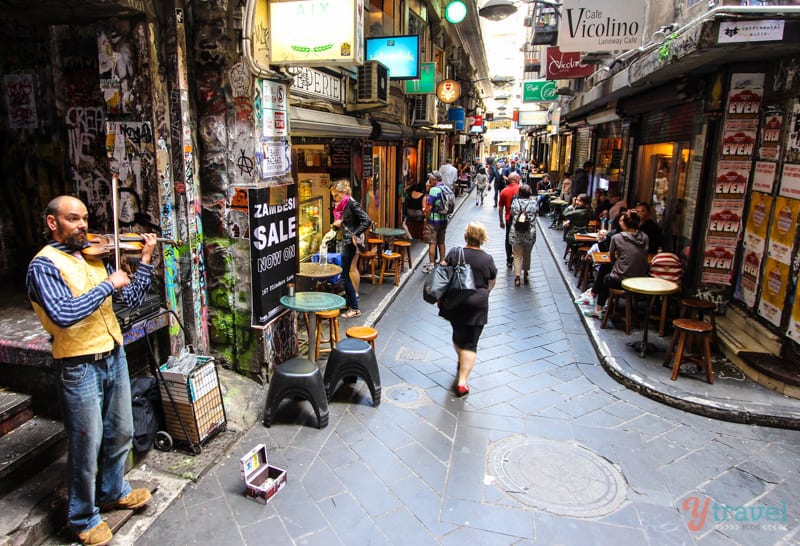
- Coffee – Melbournians are obsessed with coffee and make it better than most. Here’s a list of some best coffee spots on Lonely Planet and the Tourism Australia website.
- South Bank – a nice place to walk around on the Yarra River with great views back over the city, and endless dining and bar options.
- Riverland Urban Beer Garden – just down by Fed Square and next to the Yarra is a great spot for a beer and a meal in the sun and to watch the rowers on the river and overlooks the Princess Bridge. Feels like London in the summer. They have a kids menu too!
- Hosier Lane – a much-celebrated landmark due to its sophisticated urban art (graffiti-lined walls). A 2 minute walk from Federation Square and runs between Flinders St and Collins St. Local and international artists use the walls as a temporary canvas for their works, and the art is very interesting to look at.

- Chinatown – if there’s a Chinatown in town, we’re there! Rarely are we disappointed, and our bank balance is always happy. One place in Melbourne we kept going back to was the popular Camy Shanghai Dumpling and Noodle Restaurant – not for the posh and fancy, it’s a genuine Chinese experience with below-par service, but their dumplings were a highlight and cheap!
- Botanic Gardens – take the family for a picnic or sit on the banks of the Yarra and watch the world go by.
- Cycle the Bayside Foreshore – stretch your legs on a bike ride from St Kilda to Brighton Beach and check out the colourful bathing boxes.

- Eureka Tower – offers stunning views from the highest observation deck in the southern hemisphere, Eureka Skydeck at 297 metres/88 floors. I recommend going up just on sundown so you experience Melbourne by day and as it slips into night.
- Walk along the Yarra River and have a BBQ on the river bank in Summer.
Where to stay in Melbourne
Melbourne is a huge city with so many great accommodation options. We recommend staying in the CBD to make sure you’re near all the best attractions. Here are some of our favourite places to stay:
Budget accommodation in Melbourne:
Mid-level accommodation in Melbourne:
Luxury accommodation in Melbourne:
21 Days and Beyond…
By now you are probably realizing that three weeks is not a lot of time in Australia. You’ll find that time flies by and you’ll have very little time for relaxation when packing in all these amazing attractions.
So we do understand that some people like to extend their trip and take their time.
If you have the luxury of adding an extra week or more, that’s great! Here are some ideas for how you can extend your trip for another 7 days:
Road Trip From Cairns to the Gold Coast

One of the ways we would recommend extending this trip is to road trip from the Gold Coast to Cairns. This would be starting the trip instead of flying straight to Cairns from Sydney.
There are many sights on the East Coast that offer more chances for you to explore the natural beauty of Australia.
You’ll find stunning tropical islands, places to relax, more areas to scuba dive the barrier reef, and best of all, some time basking on the best beaches in Australia.
Here are some sights on the East Coast you could visit:
- The Whitsunday Islands – How to describe the Whitsundays…they are simply tropical paradise. You’ll find unspoiled, white-sand beaches and some of the best natural sites in Australia. Whitehaven Beach is a protected beach that is so pure, they don’t allow you to take anything with you. The gateway to the Whitsundays is from Airlie Beach on the mainland.
- Fraser Island – this is an adventurer’s paradise. The island is a World Heritage-listed site and the only way to get around is to drive by 4WD on the beach. It’s one of the best places to see humpback whales who migrate in its waters. On calm days, you can see them close to the shore. You can access Fraser Island by ferry from Rainbow Beach.
- Magnetic Island – Just across the waters from Townsville is the weird but wonderful Magnetic Island. It’s not really magnetic, it’s named after the molten granite was pushed into the earth’s surface by a volcanic force 275 million years ago. Nowadays it’s worth visiting for its unique landscapes, granite boulders and stunning beaches and reefs.
- Brisbane – although Brisbane is a city and much like any other in Aus, it’s worth checking out. The city has a thriving arts scene and has lots of hipster cafes and bars. For those who enjoy nightlife, you’ll enjoy spending some time in Brisbane.
- Byron Bay – This is one of Australia’s top beaches and is just South of Brisbane. It’s famous for surfing and is one of the best spots for experienced surfers to catch some big waves in the winter.
Explore the Northern Territory

Another way to extend this three week Australia itinerary by a week or so is to explore the Northern Territory.
You could easily fly from Alice Springs to Darwin and spend a week exploring Kakadu National Park, the largest national park in Australia and famous for its aboriginal heritage and ancient rock art. You. can also see wild salt water crocodiles here.
Darwin is also a cool city to visit. The nearby Litchfield National Park just south of Darwin is also a popular park to check out. It has some stunning waterfalls and waterholes you can swim in, which is the main reason to visit.
Before You Go
So there you have it! That’s a three week Australia itinerary covering all the highlights of this massive country. As you can see, there is a lot of time spent on planes and in cars, but that’s the only way to see the best of Australia in three weeks.
Before you go, I have one final word of advice for you. Book in advance. You will save yourself a lot of time and money if you book your flights (especially internal flights) and car rentals in advance.
You can be flexible with accommodation and activities, but don’t leave transport to the last minute or you’ll end up paying for it.
And above all, have the best time in Australia, our home. We know this itinerary skips Perth and Western Australia and the natural wonders of Tassie, but we would rather give you an itinerary that’s realistic and achievable.
We hope this itinerary helped you plan your Australia trip! If you found it helpful, please consider sharing. You can use the image below to share to Pinterest.
Tours of Australia
If you were looking for group tour options in Australia, rather than traveling independent. Our preferred partner Globus has a range of Australian tours. Click links below and be sure to use our exclusive code in the blue box below.
- See all Globus Australia tours here
- See all Cosmos tours here (part of the Globus brand)
GLOBUS DISCOUNT JUST FOR YOU!
We’ve secured an exclusive yTravel discount: Save $100 per person on select 2023 and 2024 Globus and Avalon Waterway Vacations. Use the code: YTRAVEL when booking online at the Globus, Cosmos, and Avalon Waterways websites, by calling Globus and Avalon Waterways directly, or booking with a preferred Travel Advisor. Terms & Conditions.

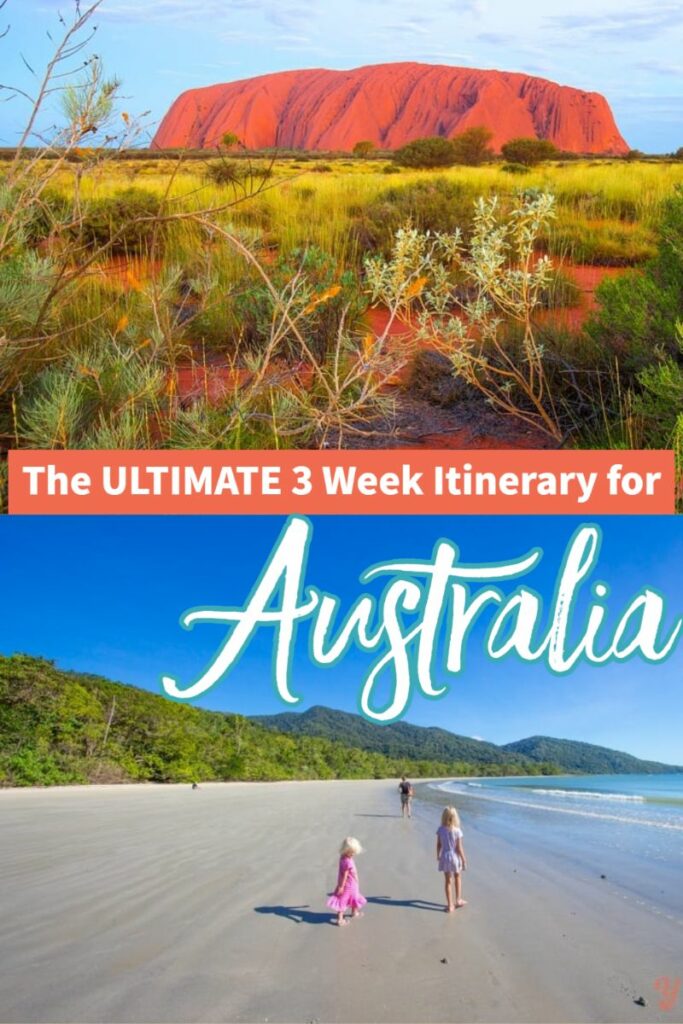
Are you planning to visit Australia? Need any tips for your three week Australia itinerary? Please leave any comments or questions in the comment section below!